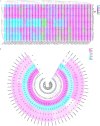Comprehensive elucidation on the genetic profile of the Hezhou Han population via an efficient InDel panel
- PMID: 40007634
- PMCID: PMC11850652
- DOI: 10.1093/fsr/owae021
Comprehensive elucidation on the genetic profile of the Hezhou Han population via an efficient InDel panel
Abstract
The Han nationality is widely distributed in different regions, and it is one of the most populous nationalities in China. Compared with the ethnic minorities in Guangxi Zhuang Autonomous Region, there is relatively less research on Han individuals dwelled in Guangxi as a part of Chinese Han population. In this study, the genetic polymorphisms of 57 autosomal insertion/deletion (InDel) loci were explored in Hezhou Han (HZH) population. Forensic-related parameters revealed that these 57 InDel loci had high forensic validity and could be used in forensic practice application. In addition, the genetic relationships between the HZH population and 30 worldwide reference populations were explored using a variety of analytical methods, such as phylogenetic tree, principal component analysis, and genetic structure analysis. These results demonstrated that there were closer genetic relationships between the HZH and nine populations from East Asia (EAS). The prediction accuracy rates of five inter-continental cross-validation analyses for individuals from EAS was >0.9, and the prediction accuracy rates of three inter-continental cross-validation analyses for individuals from EAS, Europe, and Africa were all >0.95. In addition, 24 of the 57 InDel loci could be served as ancestral information inference loci, which could effectively distinguish individuals of EAS, Europe, and Africa. In conclusion, these InDel loci could be used not only as a good tool for individual identification and paternity testing in HZH population, but also as an auxiliary tool for ancestry information inference research.
Keywords: Hezhou Han population; InDel; ancestry information inference; cross-validation; genetic relationship.
© The Author(s) 2024. Published by OUP on behalf of the Academy of Forensic Science.
Figures






References
-
- Cortellini V, Brescia G, Carnevali E, et al. Genetic data and comparative study of 38 autosomal InDel markers in three Italian population groups. Forensic Sci Int Genet. 2020;44:102170. - PubMed
-
- Li L, Ye Y, Song F, et al. Genetic structure and forensic parameters of 30 InDels for human identification purposes in 10 Tibetan populations of China. Forensic Sci Int Genet. 2019;40:e219–e227. - PubMed
LinkOut - more resources
Full Text Sources

